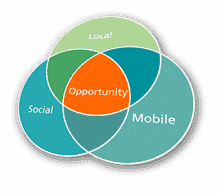SoLoMo is an acronym for Social + Local + Mobile marketing and it is a common term referring to a marketing approach that is still relevant today. You may have read plenty about each of the individual elements; if so, you’re likely to be asking questions like:
- Isn’t this just semantics?
- What’s so different?
- Where is the opportunity?
Good questions. Hopefully when you’ve finished reading this post, I’ll dispel any question about whether SoLoMo is just a matter of semantics, and I’ll prove to you that a traditional marketing approach will leave marketers disappointed. In contrast, marketers who approach today’s SoLoMo consumer with a new mindset are delving into exciting territory with plenty of opportunity.
Before explaining its importance and relevance to marketers, I’ll briefly touch on each of the three aspects of SoLoMo: social, local, and mobile.
Social: Consumers are Social

By social, I mean, not only are potential customers talking a lot, but with the prevalence of social technology, they are well connected. Consumers are now able to receive and transmit information more easily and instantaneously than ever before across mobile technologies, which has transformed the way they buy products and services.
Consumers no longer look to brands as the primary source of information; today they are more likely to consult third party resources and others in their social networks, including social media. Common social activities are seeking advice, reading or writing reviews, or sharing their experiences with their social network.
“What are the implications of all this sharing and connectedness?” Get this: one research study suggests that 81% of purchasing decisions were directly influenced by consumers’ friends’ online recommendations and posts. 78% said they were equally influenced by the posts from the businesses they follow in social media. How’s that for O-P-P-O-R-T-U-N-I-T-Y? Digital marketing cannot afford to ignore SoLoMo.
Further Reading: Social Media Demographics: What Marketers Need to Know in 2025
Mobile: Today’s Consumer is Largely Defined by Their Mobility
The mobility of consumers, coupled with the ability to shop on their smartphones or tablets makes the modern shopping experience one that looks nothing like that of yesteryear.
Shopping used to be a much different experience; just a few decades ago, many families would put on their Sunday best to go shopping downtown and make a day of it. No longer is shopping an activity in and of itself. Now, shopping can be almost an afterthought, done in pajamas at home, or from the passenger seat of a car while traveling, as mobile devices reign supreme even when searching for groceries.
A whopping 84% of US households already own a smartphone. Tablets are only slightly behind at 63%. In another study, 82% of smartphone owners consult their phones when in-store and about to make a purchase. Mobile devices are influencing consumer behaviors in ways that were unimaginable only a few short years ago.
Don’t overlook the fact that consumer mobility increases the necessity of merging social and mobile. Your Favorite Social Site Can Also Be Your Mobile Site’s Best Friend highlights how utilizing social platforms with benefits specific to mobile users is one way to ensure your business isn’t behind the curve in its digital marketing strategy.
Local: Consumers Get Social Where They Are

80% of smartphone users currently have location-based services enabled.
Typically location-based platforms are driven by some type of promotional offer, in which a company offers an opportunity for consumers to comment, rate, and share their experiences with their business. Although there are many local platforms like Yelp, Nextdoor, etc., don’t overlook email. Amazon is using email to deliver hyper-local offers for location-based marketing.
38% of smartphone owners were open to receiving promotional messages via SMS when the messages were based on their location. This statistic reveals what an opportunity local marketing can be; local relevance heightens consumer interest in receiving messages right where they are, which is quite the antithesis to usual consumer reaction to unwanted email/junk-mail promotions.
Further Reading: 7 Local SEO Tips For Small Business Owners
New Marketing Landscape
So, how is SoLoMo different? The opportunity is found in creating a dynamic, relevant customer experience by:
- Linking the three elements together. Engage consumers at the intersection of social, mobile and local.

- Aligning all internal resources, especially those in direct contact with the consumer. This is crucial for SoLoMo to be successful. If you’re successfully running a promotion, but your front-line staff isn’t trained and aware, missed opportunity is inevitable.
Consumers’ seamless moves between channels and social media platforms make it incumbent on marketers to have an integrated strategy. Someone can check in to a store using a location based app like Foursquare, redeem an offer, share a comment on that platform, then immediately post an update to their Facebook wall or other platform, all while referencing the retailer’s Facebook page.
Businesses must also be aware of other location based applications such as SCVNGR, Yelp, and Around Me that allow consumers to rate and comment on their experience.
New SoLoMo Mindset Required
A SoLoMo marketing strategy has the customer experience at the very heart. Increasingly, consumers want to be part of the process. Most marketers are conditioned to “sell”. Traditional marketing is about determining the product or service benefits based on features, then packaging these in marketing materials.
The new mindset for marketing teams is about helping consumers by providing relevant content to help them find, buy, and use your products or services.
Overwhelmed by Digital Marketing?
Just released: my new book to help small businesses, entrepreneurs, and marketers master digital marketing in today’s digital-first world.
Drawing on my Fractional CMO experience, Digital Threads simplifies complex strategies into clear, actionable steps for success.
Transform your business today—grab your copy! Click the cover or button below to buy on Amazon.
This new approach begins by focusing on the consumer. Now more than ever marketer’s must “walk in a customer’s shoes” and identify where the customer experience isn’t up to par. This requires embracing a growth mindset, being curious, asking questions, and thoughtfully considering each step of the buying cycle. Stepping through the customers’ path to purchase, diligently pursue solutions and content for the multitude of ways customers happen upon your place of business.
Listen to conversations taking place in this new space. Audit your social presence and be sure to avoid common mistakes companies make when mixing social and marketing. Then adapt to the needs and challenges being articulated by consumers. There is no “one size fits all” solution; implementing solutions in this land of opportunity will require experimentation.
Of course, the critical goal is still selling products or services, but hopefully in a way that creates loyal consumers who will ultimately use more of what you have to offer and tell others too…in large part because of the stellar customer experience you’ve provided.
Leverage Your Google Business Profile
A Google Business Profile, formerly called Google My Business, is probably one of the best – and free – SoLoMo tools that exists for every sized business to use.
A Google business profile is invaluable in social marketing–and in particular, for SoLoMo marketing efforts, as it vastly improves user experience, and can help businesses reach consumers who may not know about them yet, but are searching for a specific need. When someone hops on a mobile phone, for instance, and searches for a coffee shop on Google, businesses who utilize Google Business Profiles will be able to show up as a local business on mobile, potentially with a link to their social profile. This meets all of the qualifications for SoLoMo, and can bridge the gap between customer searches that are already familiar with your business, and those that are in need of what your company has to offer.
SoLoMo Opportunity
A successful SoLoMo strategy benefits marketers, not only by increasing business, but by transforming consumer behaviors. When SoLoMo campaigns are successful, consumer engagement with the brand increases. Consumers feel connected to the brand and become loyal brand advocates. Through word-of-mouth sharing, consumers can build a brand. Loyal consumers are also willing to offer feedback and help identify issues that the brand can improve upon. Knowing that they have a voice, consumers and businesses benefit from a spirit of collaboration, co-creation and innovation, which turns into a win-win.
What ways is your company embracing SoLoMo marketing?
Hero photo by Sharon McCutcheon on Unsplash











where is the year of this article?